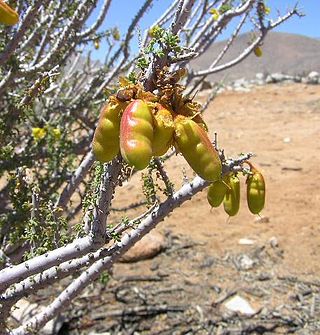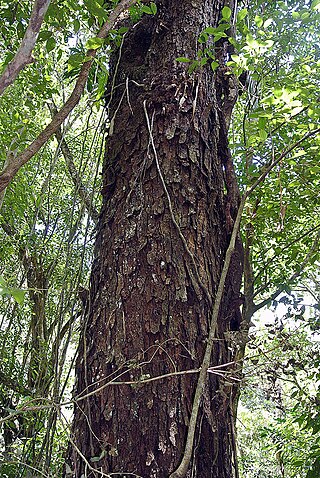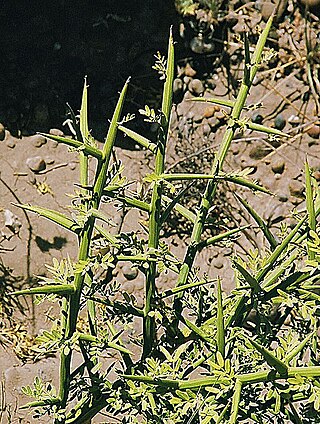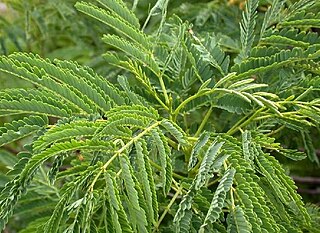
The Mimosoideae are a traditional subfamily of trees, herbs, lianas, and shrubs in the pea family (Fabaceae) that mostly grow in tropical and subtropical climates. They are typically characterized by having radially symmetric flowers, with petals that are twice divided (valvate) in bud and with numerous showy, prominent stamens.

The Fabaceae or Leguminosae, commonly known as the legume, pea, or bean family, are a large and agriculturally important family of flowering plants. It includes trees, shrubs, and perennial or annual herbaceous plants, which are easily recognized by their fruit (legume) and their compound, stipulate leaves. The family is widely distributed, and is the third-largest land plant family in number of species, behind only the Orchidaceae and Asteraceae, with about 765 genera and nearly 20,000 known species.
Stuhlmannia moavi is a species of flowering plants in the legume family, Fabaceae. It is the only species in the genus Stuhlmannia. It is a tree native to Kenya, Tanzania, and Madagascar, where it grows in seasonally-dry tropical forest, woodland on limestone, and in riverine forest. The genus belongs to tribe Caesalpinieae in subfamily Caesalpinioideae.

Hoffmannseggia is a genus of flowering plants in the pea family, Fabaceae, known generally as rushpeas. These are pod-bearing herbs and subshrubs native to the Americas. In North America they range from California and Nebraska to southern Mexico, and from Colombia, Ecuador, and Peru to southern Argentina and Chile in South America. The generic name honors Johann Centurius, Count of Hoffmannsegg, a nineteenth-century German nobleman and botanist.

Haematoxylum is a genus of flowering plants in the legume family, Fabaceae, subfamily Caesalpinioideae and the tribe Caesalpinieae. It includes five species, four of which are native to the tropical Americas from Mexico to Colombia, and one to Namibia.

Cercidoideae is a subfamily in the pea family, Fabaceae. Well-known members include Cercis (redbuds), including species widely cultivated as ornamental trees in the United States and Europe, Bauhinia, widely cultivated as an ornamental tree in tropical Asia, and Tylosema, a semi-woody genus of Africa. The subfamily occupies a basal position within the Fabaceae and is supported as monophyletic in many molecular phylogenies. At the 6th International Legume Conference, the Legume Phylogeny Working Group proposed elevating the tribe Cercidae to the level of subfamily within the Leguminosae (Fabaceae). The consensus agreed to the change, which was fully implemented in 2017. It has the following clade-based definition:
The most inclusive crown clade containing Cercis canadensisL. and Bauhinia divaricataL. but not Poeppigia proceraC.Presl, Duparquetia orchidaceaBaill., or Bobgunnia fistuloides(Harms) J.H.Kirkbr. & Wiersema.

Balsamocarpon brevifolium, or algarrobilla, is a species of flowering plants in the legume family, Fabaceae. It is the sole species in genus Balsamocarpon. Balsamocarpon belongs to the subfamily Caesalpinioideae and tribe Caesalpinieae. It is endemic to northern and north-central Chile.
Pomaria is a genus of flowering plants in the legume family, Fabaceae. It includes 16 species of shrubs and perennial herbs native to North America, South America, and southern Africa. Typical habitats include drier subtropical grasslands and wooded grasslands, often on limestone, and degraded areas. It belongs to tribe Caesalpinieae of subfamily Caesalpinioideae.
Stenodrepanum bergii is a species of flowering plants in the legume family, Fabaceae. It is a perennial subshrub native to northern Argentina. It is the sole member of genus Stenodrepanum. It belongs to tribe Caesalpinieae in subfamily Caesalpinioideae.

Parapiptadenia is a genus of flowering plants in the family Fabaceae. It includes six species of trees and shrubs native to eastern and southern Brazil, Bolivia, Paraguay, Uruguay, and northern Argentina. Typical habitats include tropical coastal and dune forest (restinga), woodland, scrub, and secondary growth forest. It belongs to the mimosoid clade of the subfamily Caesalpinioideae.
Piptadeniopsis lomentifera is a species of flowering plant in the legume family, Fabaceae. It is a tree native to southwestern Bolivia and Paraguay. It is the sole species in genus Piptadeniopsis. It belongs to the mimosoid clade of the subfamily Caesalpinioideae.

Prosopidastrum is a genus of flowering plants in the family Fabaceae. It includes seven species of shrubs native to the subtropical Americas, with six species native to Bolivia and Argentina, and one native to Baja California. They grow in subtropical xerophytic bushland, thicket, grassland, and semi-desert. It belongs to the mimosoid clade of the subfamily Caesalpinioideae.

Schleinitzia is a genus of flowering plants in the family Fabaceae. It includes four species of trees and shrubs native to the Philippines, New Guinea, and the South Pacific. Typical habitats include tropical secondary rain forest, woodland, wooded grassland, coastal plain, and beaches. It belongs to the mimosoid clade of the subfamily Caesalpinioideae.

The tribe Caesalpinieae is one of the subdivisions of the plant family Fabaceae: subfamily Caesalpinioideae.
Erythrostemon is a genus of flowering plants in the legume family, Fabaceae. Its native range is tropical & subtropical America.
Coulteria is a genus of flowering plants in the legume family, Fabaceae. It belongs to the subfamily Caesalpinioideae. It includes ten species native the tropical Americas, from northern Mexico through Central America to Colombia and Venzezuela, including Cuba and Jamaica.

Tara is a genus of flowering plants in the legume family, Fabaceae. It includes three species of trees and shrubs native to the tropical Americas, from northern Mexico through Central America, the Caribbean, and western South America to Bolivia and Central Chile. Typical habitats include seasonally-dry tropical forest and semi-arid thorn scrub. It belongs to tribe Caesalpinieae of subfamily Caesalpinioideae.
Arquita is a genus of flowering plants in the family Fabaceae. It belongs to the subfamily Caesalpinioideae. It includes five species, which range from Ecuador to northern Argentina.
Hererolandia pearsonii is a species of flowering plants in the family Fabaceae. It is the sole species in genus Hererolandia. It is a shrub endemic to Namibia where it grows in Karroo-Namib shrubland. It belongs to tribe Caesalpinieae of subfamily Caesalpinioideae.
Mimozyganthus is a genus of flowering plants in the family Fabaceae. It includes a single species, Mimozyganthus carinatus, a tree native to Bolivia, Paraguay, and northwestern Argentina, where it is known by the common names iscayante and lata. It belongs to the mimosoid clade of the subfamily Caesalpinioideae.










